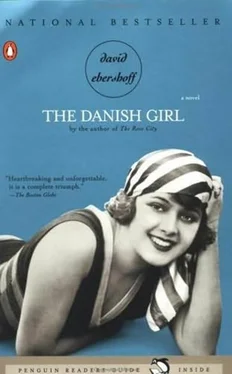They met in a café on the rue St-Antoine at a table in the window that allowed Greta a view of the men and women emerging from the depths of the Métro, their faces soured by the weather. Professor Bolk was waiting for her, his thimble of espresso drained. He seemed displeased with her for arriving late; Greta offered up her excuses-a painting she couldn’t leave, the telephone ringing-while Professor Bolk sat stone-faced, scraping the underside of his thumbnail with a little stainless-steel knife.
He was handsome, Greta thought, with a long face and a chin that was dimpled like the bottom of an apple. His knees did not fit properly beneath the tabletop, which was round and stained, the marble scratched and rusted and as rough as slate. A little band of cut-out brass circled the piece of marble, and Greta found it uncomfortable to lean in to talk privately with Professor Bolk, the piece of brass pressing into the underside of her arm.
“I can help your husband,” Professor Bolk was saying. At his feet was a bag with a gold buckle and half-loop handles, and Greta wondered if it could be as simple as Professor Bolk arriving at the casita’s door with that black bag and spending a few hours alone with Einar. She told herself it wouldn’t work out like that, but she wished it could, the way she sometimes wished Carlisle would rub enough spearmint oil into his bad leg and it would heal, or the way she had wished Teddy Cross would sit in the sun long enough to burn the illness from his bones.
“But he won’t be your husband when I’m finished,” Professor Bolk continued, opening his bag. He pulled out a book covered in green mar bleized paper, the leather of the spine chipped and worn like the seat of an old reading chair.
Professor Bolk found the right page, and then he looked up, his eyes meeting Greta’s, uncaging a wingbeat in her chest. On the page was a diagram of a man’s body showing both the skeleton and the organs in a busy display of parallel and crossing lines that made Greta think of one of the Baedeker maps from Paris and Its Environs Carlisle had used when he first arrived. The man in the diagram represented an average adult male, Professor Bolk explained; his arms were spread out, and his genitals were hanging like grapes on a vine. The page was dog-eared and smudged with pencil markings.
“As you can see,” Professor Bolk said, “the male pelvis is a cavity. The sex organs hang outside. In the pelvis there’s nothing much but the lines of intestine, all of which can be rearranged.”
Greta ordered a second coffee, and was suddenly struck with a desire for a dish of quartered oranges; something made her think of Pasadena.
“I’m curious about your husband’s pelvis,” Professor Bolk said. It was a strange way of putting it, Greta thought, although she liked Professor Bolk, warming to him as he told her about his training. He had studied in Vienna and Berlin, at the Charité Hospital, where he was one of the few men ever to develop specialties in both surgery and psychology. During the war, when he was a young surgeon whose legs were still growing and whose voice hadn’t dropped to its final basso timbre, he amputated more than five hundred limbs-if one counted all the fingers he chopped off in an attempt to salvage a hand half-destroyed by a grenade whose lead time was a little shorter than the captain had promised. Bolk had operated in tents whose flap doors trembled in the wind of bombs; sacrificing a leg but saving a man, all in the glow of matchlight. The ambulance runners would serve up on wood-board stretchers men with their abdomens blown apart, sliding the half-alive soldiers onto Professor Bolk’s operating table, which was still wet from the previous man’s blood. The first time Bolk received a man like that, with the middle of his body reduced to an open bowl of guts, Bolk couldn’t think of what to do. But the man was dying in front of him, the soldier’s eyes rolling in his head and begging Bolk for help. The gas tanks were almost empty, and so there was no way to put the man fully out. Instead, Bolk lay a sheet of gauze across the young man’s face and set to work.
It was winter, and hailstones were pelting the tent, and the torches were blowing out, and the corpses were stacked like firewood, and Bolk decided that if he could sort out enough of the intestines-the liver and kidneys were okay, in fact-then maybe the boy could live, although he would never shit properly again. The blood seeped up Bolk’s sleeves, and for an hour he didn’t lift the gauze from the boy’s face because, even though he was unconscious from the pain, Bolk knew he couldn’t bear to see the agony fluttering in the boy’s eyelids. Bolk sewed carefully, unable to see much. As a boy Bolk had skinned pigs, and the inside of the soldier felt no different from that of a hog: warm and slick and dense, like plunging your arm into a pot of winter stew.
As the night deepened and the shelling lifted but the freezing rain fell only harder, Bolk began to stretch what was left of the soldier’s skin over his wound. There was a nurse in a bloodied apron, Fräulein Schäpers, and the patient she’d been attending had just vomited his innards on her, and then instantly died. She took half a minute to wipe her face and then joined Bolk. Together they stretched the soldier’s skin, from just beneath his sternum to the flaps of it hanging over his pelvis. Fräulein Schäpers held the flesh together as Bolk ran a cord thicker than a bootlace through the soldier, pulling the skin as tight as the canvas seats of the collapsing stools in the tent with the stovepipe chimney that served as their canteen.
The young man lived, at least long enough to be loaded into an ambulance truck racked with shelves for the patients, shelves that would make Bolk think of the bakery trucks that used to careen around Gendarmen markt, delivering the daily loaves on which he would dine when he was a medical student and poor and determined to become a doctor all of Germany would admire.
“Five hundred limbs and five hundred lives,” Professor Bolk said to Greta at the café on the rue St-Antoine. “They say I saved five hundred lives, although I can’t really be sure.”
Outside, leaves were stuck to the top step of the entrance of the Métro, and people would arrive and slip, although everyone managed to catch the green copper rail just in time. But Greta watched, waiting for someone to fall and scrape his hand, or worse, although Greta didn’t want to see it, she just knew it would happen.
“When can I meet your husband?” Professor Bolk asked.
Greta thought of Einar on the steps of the Royal Academy of Fine Arts; even at that age-he was already a professor, for heaven’s sake-Einar looked like a boy just on the eve of puberty, as if they both knew in the morning he would lift his arm to wash and discover the first thread of gold-brown hair. He had never been right physically, Greta knew. But now she wondered if it had ever mattered. Perhaps she should send Professor Bolk back to Dresden alone, she thought, playing with the spoon in her coffee cup. She suddenly wondered whom she loved more, Einar or Teddy Cross. She told herself it didn’t matter, although she didn’t believe it. She wished she could decide and settle down with the satisfaction of the information, but she didn’t know. And then she thought of Lili: the pretty bone at the top of her spine; the delicate way she held her hands as if she were about to land them on the keys of a piano; her whispery voice like the breeze that floated up through the papery petals of the Iceland poppies that filled the planting beds of Pasadena in winter; her white ankles crossed and quiet. Whom did she love more, Greta asked herself-and then Professor Bolk cleared his throat, his Adam’s apple lifting, and said, as if there were no doubt, “So. I will see you and Lili in Dresden.”
Читать дальше












